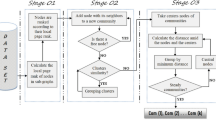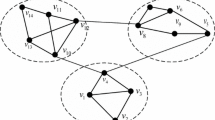Abstract
Research on the community structure of networks is beneficial for understanding the structure of networks, analyzing their characteristics and discovering the rules hidden in these networks. To address issues from previous community mining algorithms, such as the low rate of convergence and high time complexity, this study proposes an improved community structure discovery algorithm named CPMK-Means algorithm. The main idea of this algorithm can be summarised as follows. The clique percolation method (CPM) algorithm generates the maximum number of cliques by combining depth-first search with breadth-first search so that the number of cluster centres is determined. Then, the k centres are selected based on the principle of the maximum degree of centres and minimum similarity between different centres. Afterwards, nodes in the network are assigned to the communities formed by the k centres, and the iterations are performed repeatedly until the centres become stable. Finally, the overlapping communities are merged. Experiments are carried out on standard data sets Football and Collins to evaluate the performance of the CPMK-Means algorithm. Results indicate that the CPMK-Means algorithm can achieve better community mining and higher execution efficiency compared with other algorithms. Furthermore, it is superior to other algorithms in terms of precision, recall, accuracy, F-measure and separation.






Similar content being viewed by others
References
Statistic on the number of monthly active Facebook users. http://www.facebook.com
Chih-Hsiu Z, Kwang-Cheng C (2018) Social network analysis facilitates cognition in large wireless networks: clustering coefficient aided geographical routing. IEEE Trans Cogn Commun Netw 4(3):618–634
Wang Q, Dai HN, Wu D et al (2018) Data analysis on video streaming QoE over mobile networks. EURASIP J Wirel Commun Netw 2018(173):1–10
Girvan M, Newman MEJ (2002) Community structure in social and biological networks. Proc Natl Acad Sci U S A 12:7821–7826
Salehan M, Kim DJ, Koo C (2018) A study of the effect of social trust, trust in social networking services, and sharing attitude, on two dimensions of personal information sharing behavior. J Supercomput 74(8):3596–3619
Palla G, Derényi I, Farkas I, Vicsek T (2005) Uncovering the overlapping community structure of complex networks in nature and society. Nature 435(7043):814–818
Newman ME (2003) Fast algorithm for detecting community structure in networks. Phys Rev E Stat Nonlinear Soft Matter Phys 69(6):066133
Wei F, Qian W, Wang C et al (2009) Detecting overlapping community structures in networks. World Wide Web Internet Web Inf Syst 12(2):235–261
Shi C, Cai Y, Fu D et al (2013) A link clustering based overlapping community detection algorithm. Data Knowl Eng 87(9):394–404
Yang J, Leskovec J (2013) Community-affiliation graph model for overlapping network community detection. In: IEEE 12th International Conference on Data Mining. IEEE, pp 1170–1175. https://doi.org/10.1109/ICDM.2012.139
Whang JJ, Gleich DF, Dhillon IS (2016) Overlapping community detection using neighborhood-inflated seed expansion. IEEE Trans Knowl Data Eng 28(5):1272–1284
Xu Y, Xu H, Zhang D et al (2016) Finding overlapping community from social networks based on community forest model. Knowl-Based Syst 109(1):238–255
Wang ZX, Li ZC, Ding XF et al (2016) Overlapping community detection based on node location analysis. Knowl-Based Syst 105(1):225–235
Wen X, Chen WN, Lin Y et al (2017) A maximal clique based multi-objective evolutionary algorithm for overlapping community detection. IEEE Trans Evol Comput 21(3):363–377
Ruan Y, Fuhry D, Parthasarathy S (2013) Efficient community detection in large networks using content and links. In: Proceedings of the 22nd International Conference on World Wide Web. ACM, pp 1089–1098. https://doi.org/10.1145/2488388.2488483
Meo PD, Ferrara E, Fiumara G et al (2013) Mixing local and global information for community detection in large networks. J Comput Syst Sci 80(1):72–87
Arnau P, Dominguez-Sal D, Larriba-Pey JL (2014) High quality, scalable and parallel community detection for large real graphs. In: Proceedings of the 23rd International Conference on World Wide Web. ACM, pp 225–236. https://doi.org/10.1145/2566486.2568010
Moon S, Lee JG, Kang M et al (2015) Parallel community detection on large graphs with MapReduce and GraphChi. Data Knowl Eng 104(1):17–31
Hollocou A, Maudet J, Bonald T et al (2017) A linear streaming algorithm for community detection in very large networks. In: Proceedings of Knowledge Discovery and Data Mining (KDD’ 2017), Halifax-Canada, pp 1–9
Howe B, Howe B, Howe B et al (2017) Scalable and efficient flow-based community detection for large-scale graph analysis. ACM Trans Knowl Discov Data 11(3):32–62
Wu H, Gao L, Dong J et al (2014) Detecting overlapping protein complexes by rough-fuzzy clustering in protein-protein interaction networks. PLoS One 9(3):1–13
Acknowledgements
The research presented in this paper was supported by the scientific research project of education department of Hunan Province (Grant:18B412), the Natural Science Foundation of Hunan Province (Grant: 2019JJ50689), China Postdoctoral Science Foundation (Grant: 2018 M642974).
Author information
Authors and Affiliations
Corresponding author
Ethics declarations
Competing interests
The authors declare that they have no competing interests.
Additional information
Publisher’s note
Springer Nature remains neutral with regard to jurisdictional claims in published maps and institutional affiliations.
Zhou Zhou and Zhuopeng Xiao are co-first authors
Rights and permissions
About this article
Cite this article
Zhou, Z., Xiao, Z. & Deng, W. Improved community structure discovery algorithm based on combined clique percolation method and K-means algorithm. Peer-to-Peer Netw. Appl. 13, 2224–2233 (2020). https://doi.org/10.1007/s12083-020-00902-9
Received:
Accepted:
Published:
Issue Date:
DOI: https://doi.org/10.1007/s12083-020-00902-9




